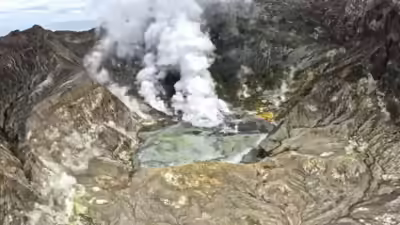White Island (Whakaari) Erupts — Flights Disrupted, Alert Raised

White Island (Whakaari) Erupts — Flights Disrupted, Alert Raised
In News:
White Island / Whakaari, an active volcanic island in New Zealand’s Bay of Plenty, erupted on Thursday morning producing an ash-and-steam plume that grounded several domestic flights and led government scientists to warn that the elevated activity could continue for “weeks to months.” Air New Zealand temporarily cancelled flights to/from the Bay of Plenty region before resuming services while monitoring conditions.
Key Facts:
- The Volcanic Alert Level (VAL) for Whakaari was raised to Level 3 (out of 5) after satellite and monitoring data showed increased ash and gas emissions and the appearance of a new vent.
- Ash plumes and steam columns were observed, with ash reported up to about 1,200 metres above sea level in some reports; ash drift toward mainland flight paths prompted precautionary flight cancellations and delays at Tauranga and Rotorua airports.
- GNS Science and meteorological services continue to monitor the volcano and advise that the current phase—characterised by intermittent, minor ash emissions—could persist for an extended period (weeks to months).
- Authorities note impacts on the mainland are expected to be minor (occasional smell of volcanic gas, mild eye/throat irritation) provided activity remains at current levels; tours to the island remain banned since the 2019 disaster.
- Aviation and emergency-management agencies are coordinating—airlines (including Air New Zealand and regional carriers) are using ash forecasts and advisories to make safety-based decisions about cancellations and re-routing.
Static Part — Key Terms & Definitions
Stratovolcano (Composite Volcano) — A conical volcano built from multiple layers of hardened lava, tephra, pumice and volcanic ash; typically capable of both explosive and effusive eruptions. Whakaari/White Island is classed within the Taupo Volcanic Arc and is a composite volcano.
Phreatic / Steam-driven Eruption — An explosive eruption caused when groundwater or surface water is rapidly heated by magma, hot rock or new volcanic intrusions, producing steam, ash and rock fragments without necessarily erupting fresh lava. Many of Whakaari’s recent episodes have involved steam, gas and ash emissions characteristic of phreatic or similar shallow processes.
Volcanic Alert Level (VAL) & Aviation Colour Code — VAL is a public-warning scale (NZ-specific) that ranges from 0–5 to indicate volcano hazard for communities; the Aviation Colour Code and ash advisories are used internationally to warn aircraft of airborne ash, which can damage jet engines and instruments. Raising VAL to 3 indicates increased eruptive behaviour requiring heightened monitoring and public caution.
Volcanic Ash / Ash Cloud — Fine fragmented volcanic rock (tephra) ejected during eruptions. Ash clouds can travel large distances on prevailing winds, pose respiratory and infrastructure hazards on the ground, and present severe risks to aviation (engine damage, instrument failure). Aviation agencies treat ash as a serious hazard and may suspend flights if ash encroaches on flight paths.
Updated - Aug 22, 2024, 09:41 PM | TOI